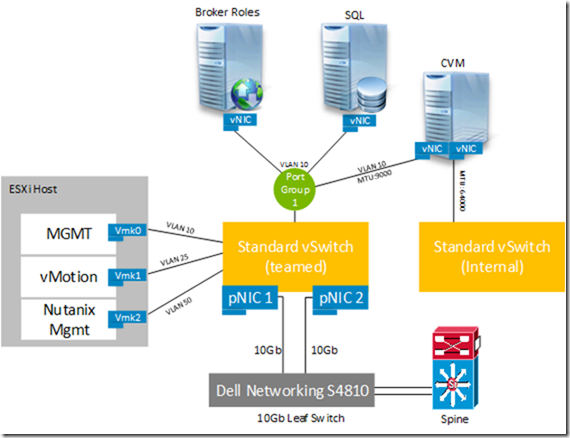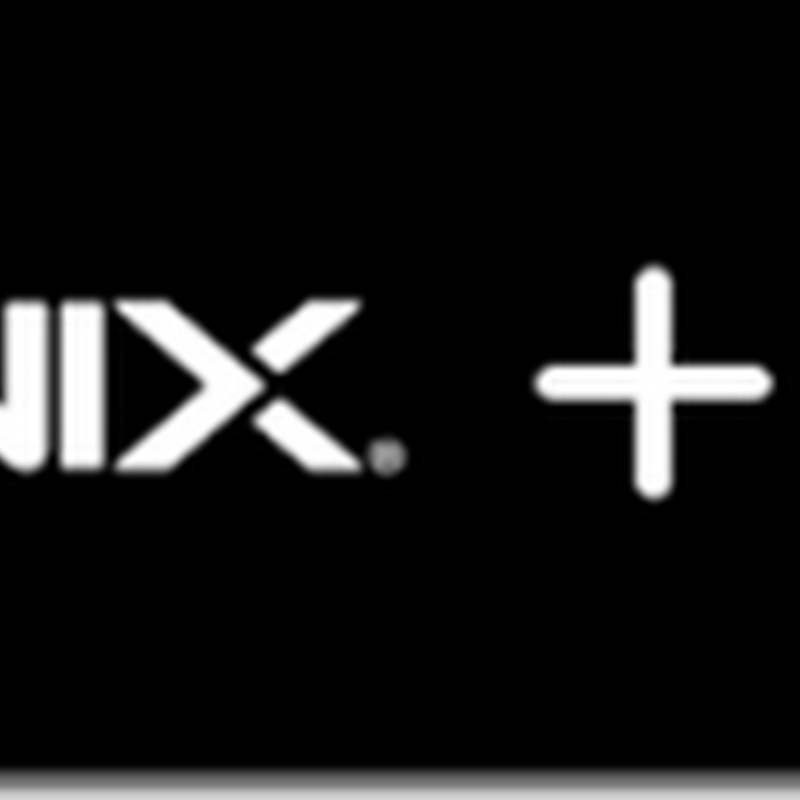Dell XC Series 2.0: Product Architectures
Following our launch of the new 13G-based XC series platform, I present our product architectures for the VDI-specific use cases. Of the platforms available, this use case is focused on the extremely powerful 1U XC630 with Haswell CPUs and 2133MHz RAM. We offer these appliances on both Server 2012 R2 Hyper-V and vSphere 5.5 U2 with Citrix XenDesktop, VMware Horizon View, or Dell vWorkspace. All platform architectures have been optimized, configured for best performance and documented.


At 1U with dual CPUs, 24 DIMM slots and 10 drive bays…loads of potential and flexibility!

The first solution I’ll cover is Dell’s Wyse vWorkspace which supports either 2012 R2 Hyper-V or vSphere 5.5. For small deployments or POCs we offer this solution in a “floating mgmt” architecture which combines the vWorkspace infrastructure management roles and VDI desktops or shared session VMs. vWorkspace and Hyper-V enables a special technology for non-persistent/ shared image desktops called Hyper-V Catalyst which includes 2 components: HyperCache and HyperDeploy. Hyper-V Catalyst provides some incredible performance boosts and requires that the vWorkspace infrastructure components communicate directly with the hyper-V hypervisor. This also means that vWorkspace does not require SCVMM to perform provisioning tasks for non-persistent desktops!

Above ~1000 users we recommend the traditional distributed management architecture to enable more predictable scaling and performance of both the compute and management hosts. The same basic architecture is the same and scales to the full extent supported by the hypervisor, is this case Hyper-V which supports up to 64 hosts. NDFS does not have a scaling limitation so several hypervisor clusters can be built within a single contiguous NDFS namespace. Our recommendation is to then build independent Failover Clusters for compute and management discretely so they can scale up or out independently.
The architecture below depicts a B7 build on Hyper-V applicable to Citrix XenDesktop or Wyse vWorkspace.

This architecture is relatively similar for Wyse vWorkspace or VMware Horizon View on vSphere 5.5 U2 but fewer total compute hosts per HA cluster, 32 total. For vWorkspace, Hyper-V Catalyst is not present in this scenario so vCenter is required to perform desktop provisioning tasks.

For the storage containers, the best practice of less is more still stands. If you don’t need a particular feature don’t enable it, as it will consume additional resources. Deduplication is always recommended on the performance tier since the primary OpLog lives on SSD and will always benefit. Dedupe or compression on the capacity tier is not recommended, of course you absolutely need it. And if you do prepare to increase each CVM RAM allocation to 32GB.
Hyper-V and vSphere are functionally similar. For Hyper-V there are 2 vSwitches per host, 1 external that aggregates all of the services of the host management OS as well as the vNICs for the connected VMs. The 10Gb NICs are connected to a LBFO team configured in Dynamic Mode. The CVM alone connects to a private internal vSwitch so it can communicate with the hypervisor.

In vSphere it’s the same story but with the concept of Port Groups and vMotion.

We have tested the various configurations per our standard processes and documented the performance results which can be found in the link below. These docs will be updated as we validate additional configurations.
About Wyse vWorkspace HyperDeploy
SJbWUYl4LRCwFNcatHuG

Platforms
We have three platforms to choose from optimized around cost and performance, all being ultimately flexible should specific parameters need to change. The A5 model is the most cost effective leveraging 8-core CPUs, 256GB RAM 2 x 200GB SSDs for performance and 4 x 1TB HDDs for capacity. For POCs, small deployments or light application virtualization, this platform is well suited. The B5 model steps up the performance by adding four cores per socket, increasing the RAM density to 384GB and doubling the performance tier to 2 x 400GB SSDs. This platform will provide the best bang for the buck on medium density deployments of light or medium level workloads. The B7 is the top of the line offering 16-core CPUs and a higher capacity tier of 6 x 1TB HDDs. For deployments requiring maximum density of knowledge or power user workloads, this is the platform for you.
At 1U with dual CPUs, 24 DIMM slots and 10 drive bays…loads of potential and flexibility!

Solution Architecture
Utilizing 3 platform hardware configurations, we are offering 3 VDI solutions on 2 hypervisors. Lots of flexibility and many options. 3 node cluster minimum is required with every node containing a Nutanix Controller VM (CVM) to handle all IO. The SATADOM is present for boot responsibilities to host the hypervisor as well as initial setup of the Nutanix Home area. The SSDs and NL SAS disks are passed through directly to each CVM which straddle the hypervisor and hardware. Every CVM contributes its directly-attached disks to the storage pool which is stretched across all nodes in the Nutanix Distributed File System (NDFS) cluster. NDFS is not dependent on the hypervisor for HA or clustering. Hyper-V cluster storage pools will present SMB version 3 to the hosts and vSphere clusters will be presented with NFS. Containers can be created within the storage pool to logically separate VMs based on function. These containers also provide isolation of configurable storage characteristics in the form of dedupe and compression. In other words, you can enable compression on your management VMs within their dedicated container, but not on your VDI desktops, also within their own container. The namespace is presented to the cluster in the form of \\NDFS_Cluster_name\container_name.The first solution I’ll cover is Dell’s Wyse vWorkspace which supports either 2012 R2 Hyper-V or vSphere 5.5. For small deployments or POCs we offer this solution in a “floating mgmt” architecture which combines the vWorkspace infrastructure management roles and VDI desktops or shared session VMs. vWorkspace and Hyper-V enables a special technology for non-persistent/ shared image desktops called Hyper-V Catalyst which includes 2 components: HyperCache and HyperDeploy. Hyper-V Catalyst provides some incredible performance boosts and requires that the vWorkspace infrastructure components communicate directly with the hyper-V hypervisor. This also means that vWorkspace does not require SCVMM to perform provisioning tasks for non-persistent desktops!
- HyperCache – Provides virtual desktop performance enhancement by caching parent VHDs in host RAM. Read requests are satisfied from cache including requests from all subsequent child VMs.
- HyperDeploy – Provides instant cloning of parent VHDs massively diminishing virtual desktop pool deployment times.

Above ~1000 users we recommend the traditional distributed management architecture to enable more predictable scaling and performance of both the compute and management hosts. The same basic architecture is the same and scales to the full extent supported by the hypervisor, is this case Hyper-V which supports up to 64 hosts. NDFS does not have a scaling limitation so several hypervisor clusters can be built within a single contiguous NDFS namespace. Our recommendation is to then build independent Failover Clusters for compute and management discretely so they can scale up or out independently.
The architecture below depicts a B7 build on Hyper-V applicable to Citrix XenDesktop or Wyse vWorkspace.

This architecture is relatively similar for Wyse vWorkspace or VMware Horizon View on vSphere 5.5 U2 but fewer total compute hosts per HA cluster, 32 total. For vWorkspace, Hyper-V Catalyst is not present in this scenario so vCenter is required to perform desktop provisioning tasks.

For the storage containers, the best practice of less is more still stands. If you don’t need a particular feature don’t enable it, as it will consume additional resources. Deduplication is always recommended on the performance tier since the primary OpLog lives on SSD and will always benefit. Dedupe or compression on the capacity tier is not recommended, of course you absolutely need it. And if you do prepare to increase each CVM RAM allocation to 32GB.
| Container | Purpose | Replication Factor | Perf Tier Deduplication | Capacity Tier Deduplication | Compression |
| Ds_compute | Desktop VMs | 2 | Enabled | Disabled | Disabled |
| Ds_mgmt | Mgmt Infra VMs | 2 | Enabled | Disabled | Disabled |
| Ds_rdsh | RDSH Server VMs | 2 | Enabled | Disabled | Disabled |
Network Architecture
As a hyperconverged appliance, the network architecture leverages the converged model. A pair of 10Gb NICs minimum in each node handle all traffic for the hypervisor, guests and storage operations between CVMs. Remember that the storage of all VMs is kept local to the host to which the VM resides, so the only traffic that will traverse the network is LAN and replication. There is no need to isolate storage protocol traffic when using Nutanix.Hyper-V and vSphere are functionally similar. For Hyper-V there are 2 vSwitches per host, 1 external that aggregates all of the services of the host management OS as well as the vNICs for the connected VMs. The 10Gb NICs are connected to a LBFO team configured in Dynamic Mode. The CVM alone connects to a private internal vSwitch so it can communicate with the hypervisor.

In vSphere it’s the same story but with the concept of Port Groups and vMotion.

We have tested the various configurations per our standard processes and documented the performance results which can be found in the link below. These docs will be updated as we validate additional configurations.
Product Architectures for 13G XC launch:
Resources:
About Wyse vWorkspace HyperCacheAbout Wyse vWorkspace HyperDeploy
SJbWUYl4LRCwFNcatHuG






No comments: